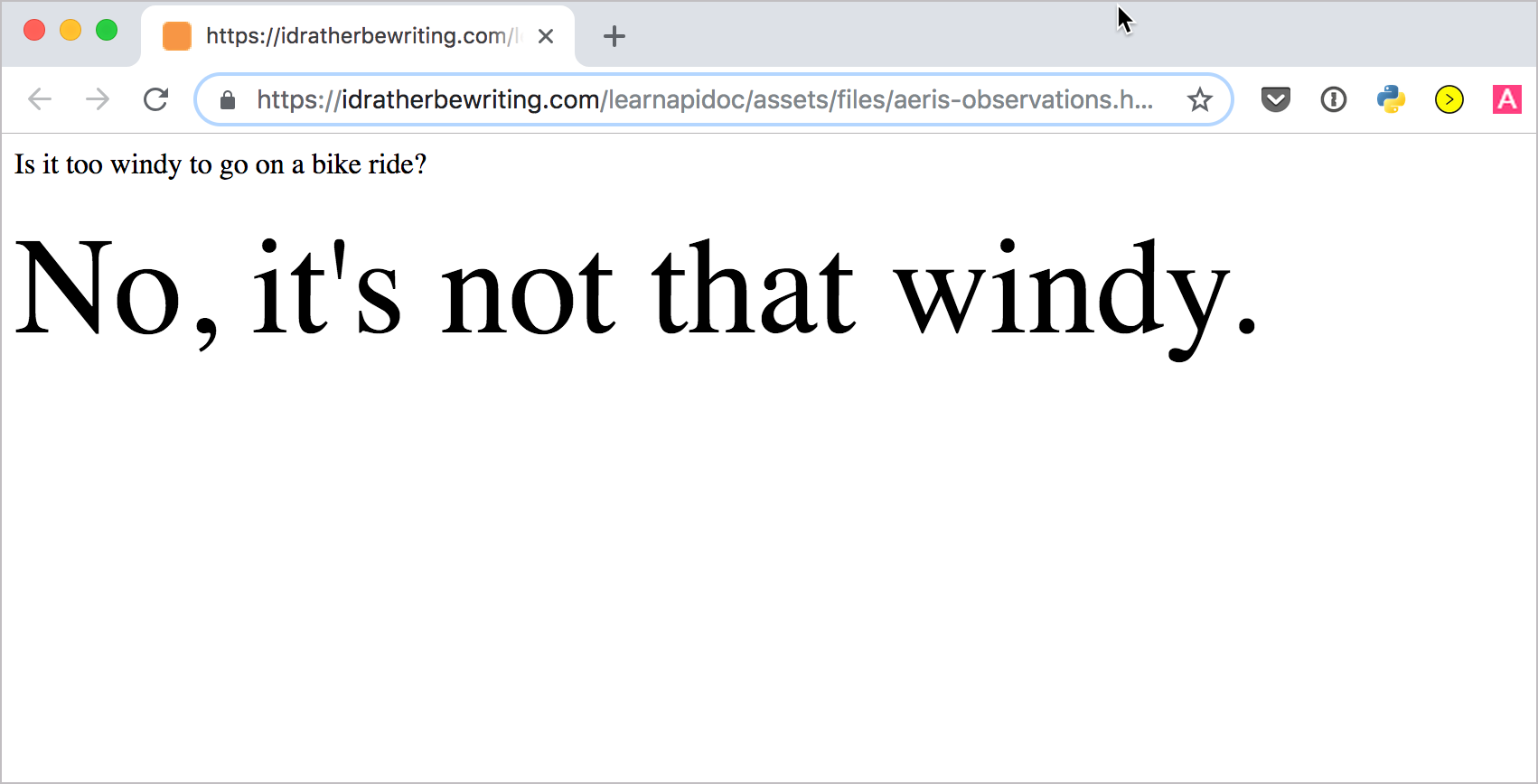Get wind speed using the Aeris Weather API
In this activity, you’ll use the Aeris Weather API to get the wind speed for a specific place (your choice). You’ll then display the wind speed on a web page based on some conditional logic about the wind speed’s value.
- The Aeris Weather API
- 1. Get the API keys
- 2. Construct the request
- 3. Analyze the response
- 4. Pull out the values from the response
The Aeris Weather API
In earlier tutorials, you integrated information from the OpenWeatherMap API. It’s probably a good idea to compare this OpenWeatherMap API with another weather API. The Aeris Weather API is one of the most interesting, well-documented and powerful weather APIs I’ve encountered.
1. Get the API keys
See the Getting Started page for information on how to register and get API keys. (Get the free version of the keys available to development projects.) You will need both the ID and secret to make API calls. See Get the Aeris Weather API secret and ID for more detail.
2. Construct the request
Browse through the available endpoints in the Weather API and look for one that would give you the wind speed. The observations endpoint provides information about wind speed, as does forecasts. The response from observations looks a little simpler, so let’s use that endpoint.
To get the forecast details for Santa Clara, California, add santa%20clara,ca after /observations, like this:
http://api.aerisapi.com/observations/santa%20clara,ca?client_id=CLIENT_ID&client_secret=CLIENT_SECRET
You will need to swap in your own client ID and secret in place of CLIENT_ID and CLIENT_SECRET in the code above.
3. Analyze the response
Here’s the response from the request:
{
"success": true,
"error": null,
"response": {
"id": "KSJC",
"loc": {
"long": -121.91666666667,
"lat": 37.366666666667
},
"place": {
"name": "san jose",
"state": "ca",
"country": "us"
},
"profile": {
"tz": "America/Los_Angeles",
"elevM": 24,
"elevFT": 79
},
"obTimestamp": 1544806380,
"obDateTime": "2018-12-14T08:53:00-08:00",
"ob": {
"timestamp": 1544806380,
"dateTimeISO": "2018-12-14T08:53:00-08:00",
"tempC": 14.4,
"tempF": 58,
"dewpointC": 6.1,
"dewpointF": 43,
"humidity": 58,
"pressureMB": 1016,
"pressureIN": 30,
"spressureMB": 1014,
"spressureIN": 29.94,
"altimeterMB": 1017,
"altimeterIN": 30.03,
"windKTS": 14,
"windKPH": 26,
"windMPH": 16,
"windSpeedKTS": 14,
"windSpeedKPH": 26,
"windSpeedMPH": 16,
"windDirDEG": 140,
"windDir": "SE",
"windGustKTS": 20,
"windGustKPH": 37,
"windGustMPH": 23,
"flightRule": "VFR",
"visibilityKM": 16.09344,
"visibilityMI": 10,
"weather": "Cloudy",
"weatherShort": "Cloudy",
"weatherCoded": "::OV",
"weatherPrimary": "Cloudy",
"weatherPrimaryCoded": "::OV",
"cloudsCoded": "OV",
"icon": "cloudy.png",
"heatindexC": 14,
"heatindexF": 58,
"windchillC": 14,
"windchillF": 58,
"feelslikeC": 14,
"feelslikeF": 58,
"isDay": true,
"sunrise": 1544800479,
"sunriseISO": "2018-12-14T07:14:39-08:00",
"sunset": 1544835063,
"sunsetISO": "2018-12-14T16:51:03-08:00",
"snowDepthCM": null,
"snowDepthIN": null,
"precipMM": 0,
"precipIN": 0,
"solradWM2": 55,
"solradMethod": "estimated",
"ceilingFT": 7000,
"ceilingM": 2133.6,
"light": 24,
"QC": "O",
"QCcode": 10,
"windGustSpeedKTS": 20,
"windGustSpeedKPH": 37,
"windGustSpeedMPH": 23,
"sky": 100
},
"raw": "KSJC 141653Z 14014G20KT 10SM FEW024 BKN070 OVC110 14/06 A3003 RMK AO2 SLP168 T01440061",
"relativeTo": {
"lat": 37.35411,
"long": -121.95524,
"bearing": 68,
"bearingENG": "ENE",
"distanceKM": 3.684,
"distanceMI": 2.289
}
}
}
windSpeedMPH is the value we want.
4. Pull out the values from the response
To get the windSpeedMPH, you would access it through dot notation like this: data.response.ob.windSpeedMPH.
To add a little variety to the code samples, let’s add some conditional logic in the display. The following code checks to see if data.response.ob.windSpeedMPH is greater than 15. If so, it prints Yes, it's too windy. If not, it prints, No, it's not that windy.
<html>
<body>
<script src="https://ajax.googleapis.com/ajax/libs/jquery/1.11.1/jquery.min.js"></script>
<script>
jQuery.ajax({
url: "http://api.aerisapi.com/observations/santa%20clara,ca",
type: "GET",
data: {
"client_id": "CLIENTID",
"client_secret": "CLIENTSECRET",
},
})
.done(function(data, textStatus, jqXHR) {
console.log("HTTP Request Succeeded: " + jqXHR.status);
console.log(data);
if (data.response.ob.windSpeedMPH > 15) {
var windAnswer = "Yes, it's too windy.";
}
else {
var windAnswer = "No, it's not that windy.";
}
$("#windAnswer").append(windAnswer)
})
.fail(function(jqXHR, textStatus, errorThrown) {
console.log("HTTP Request Failed");
})
.always(function() {
/* ... */
});
</script>
<p>Is it too windy to go on a bike ride?</p>
<div id="windAnswer" style="font-size:76px"></div>
</body>
</html>
Here’s the result:

For fun, change the value from 15 to 1 in the code and refresh the page. It will probably say “Yes, it’s too windy.” JavaScript is fun because it’s easy to adjust some parameters and see the results through your browser. With other programming languages, you would likely need to compile or run the code in an IDE to see the result. In both cases, always test out the code and make it run yourself.
138/145 pages complete. Only 7 more pages to go.

